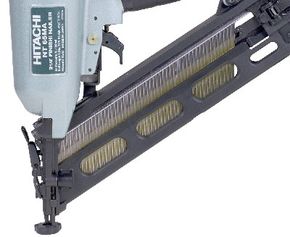Nail-loading Mechanism
The gun in this diagram uses the most popular sort of nail-loading mechanism. The nails are glued together loosely, in a long strip. This nail strip loads into the gun's magazine, which feeds into the "barrel" of the gun. Springs in the base of the magazine push the nail strip into the barrel. When the hammer comes down, it separates the first nail from the strip, driving it out of the gun and into the wood. When the hammer is cocked back, the springs push the next nail into position.
One advantage of this system is that the glue helps secure the nails. When the nail is hammered into the wood, the intense friction heats the glue to the melting point. Once the nail is in place, the glue quickly hardens again, fusing the nail to the surrounding wood.
Advertisement
In this gun, the electric motor only cocks the gun; the coiled springs do the real hammering work.
Electromagnetic Design
One effective hammering device is a solenoid. A solenoid is a simple sort of electromagnet used in a variety of machines.
If you've read How Electromagnets Work, then you know the basic idea behind electromagnetic devices: Running electricity through a wire generates a magnetic field. You can amplify this magnetic field by winding the charged wire in a coil. Just like a permanent magnet, an electromagnetic field has a polar orientation -- a "north" end and a "south" end. If you put two magnets together, the north ends repel one another, as do the south ends, but the north and south ends are attracted to each other.
In an electromagnet, you can alter the orientation of the poles. If you reverse the flow of the current, the north and south ends of the electromagnet switch places.
A solenoid is an electromagnetic coil with a sliding piston inside it. In a nail gun, the piston is made of magnetic material. When you apply current one way through the coil, the electromagnetic field repels the magnetic piston, pushing it out. But when you reverse the current, the polar orientation switches and the electromagnet draws the piston back in. Some solenoids have a spring mechanism to draw the piston back in.
An electromagnetic nail gun uses such a solenoid as a hammer. When you pull the trigger:
- The electrical circuit runs the current through the electromagnet so that the piston extends downward. Typically, the piston is attached to a sturdy blade.
- The blade makes contact with the nail, forcing it out of the gun.
- At the bottom of the cylinder, the piston hits an electrical switch.
- Throwing this switch reverses the electrical current running through the electromagnet. The electromagnet draws the piston back in for another hit.
Solenoids are effective and reliable, but they are somewhat limited in power output. A solenoid gun may not be able to drive a nail through tougher substances, at least not in a single blow. In the next section, we'll look at a more powerful type of nail gun that has dominated the market.
